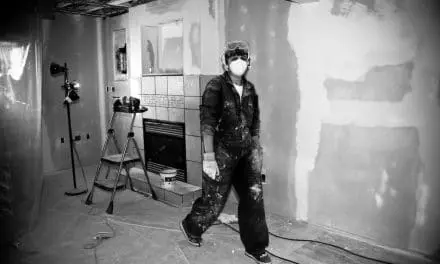by Janelle Sorensen, Content Director at Elemental Green and Chief Strategist at gro gud
Headaches, dizziness, nausea, loss of coordination…wait, are these all the scary side effects from a prescription drug commercial? Nope – they’re just some of the symptoms that can be caused by poor indoor air quality. Eco-friendly homes incorporate materials and technologies that better protect your indoor air quality. So, can an eco-friendly home improve brain function? Yep, it actually can! Today I’m sharing how your home’s indoor air quality could be negatively affecting you – and how making some eco-friendly changes could improve your mental cognition and overall health. It’s just one more good reason to make your abode an environmentally-friendly oasis that will have a positive impact on the people living within it and the environment that surrounds it.
Here’s the science:
Indoor air pollution levels are typically two to five times higher than outdoor levels and we spend about 90 percent of our time indoors. Add these facts together and that’s where mental and cognitive decline (among other things) enter the picture.
Two studies found alarming effects on cognitive performance. Researchers compared the cognitive function of people in conventional buildings vs. those in green buildings with enhanced ventilation. The improved indoor environment resulted in doubling cognitive function test scores!
In another study, two high-performing buildings were tested: one was green certified and the other was not. Both had low carbon dioxide levels, low VOCs, high ventilation rates, and had a high number of participants in the thermal comfort zone. The green-certified buildings had less indoor humidity and more lighting than the high-performing, non-certified building. There were higher cognitive scores and fewer negative health symptoms in the green-certified building. An eco-friendly building also resulted in better sleep. Participants had 6.4 percent better sleep quality in green-certified buildings. And better sleep leads to better brain function, too.
We could share more studies comparing indoor environments and cognitive function, but you get the point, right?
Where do these pollutants come from?
Everyday products and building materials
Many everyday products and building materials contain chemicals that can pose risks to our health. Volatile organic compounds (VOCs) are chemicals that are released as gasses from materials like paints, waxes, varnishes, cleaning solutions, aerosol sprays, fuels, furnishings, personal care products, and more. These products release VOCs while they are in use and even years after. Many people are not aware that their kitchen cabinets, carpet, and vinyl flooring could be a few of the culprits off-gassing VOCs in their home.
Appliances and fireplaces
Appliances, fireplaces, space heaters, and wood stoves create carbon monoxide, nitrogen dioxide, and particulate matter. Carbon monoxide poisoning can result in memory loss and other cognitive impairments (and even death if the levels get high enough). The hippocampus, which helps in the forming of new memories, is particularly affected by carbon monoxide.
Outdoor contaminants
Thought this was just about indoor air quality? It still is! Our indoor air can actually become contaminated by outdoor pollutants. For example, our homes have intake vents where pollutants can enter. If we have poorly placed plumbing vents and exhausts, pollutants that should have vented outside the building can re-enter. Harmful gasses like radon can enter through cracks in the foundation. Open windows can let in polluted air if you live near a factory or highway. And, we can even track them into our homes on the bottom of our shoes.
Reducing indoor air pollution
There are numerous ways to mitigate indoor air pollution, and many of them are super simple! Although some options are more drastic and pricey, there certainly are also affordable (sometimes free) ways to improve your home’s indoor air quality.
Avoid VOCs
- Use non-toxic cleaning products.
- Use low or zero-VOC paints, varnishes, adhesives, etc. Look for a certification like GREENGUARD to be sure.
- When using products that have VOCs, make sure you have seriously good ventilation/fresh air and wear a respirator.
- Safely get rid of leftover products that contain VOCs if you’re not going to use them soon (the gasses can leak through the container). Alternatively, don’t store them in your home.
Keep Air Circulating
- Use an indoor air purification system and filtration system.
- Ventilation in bathrooms and the kitchen should be properly placed and maintained.
- Install trickle vents in your windows. Trickle vents are very small openings that constantly allow fresh air in the home (without affecting the temperature in the home).
- If you’re looking for an inexpensive option, try opening your windows every day for at least five minutes to increase circulation.
Address Outdoor Contaminants
- Vacuum your floors and rugs. The more often, the better the results.
- Don’t wear your shoes around the house.
- If you live near a factory, highway, or busy road, keep windows closed during peak emission hours.
- Make sure your filters are clean! Make it a spring cleaning habit.
Whether you’re starting construction from scratch or doing a remodel, take steps to reduce possible sources indoor air pollution. Make sure you do your research to find companies that are environmentally responsible and avoid manufacturing with harmful chemicals. Even if you aren’t building new or remodeling, smaller steps like we mentioned above can make a significant difference, too. Eco-friendly homes are a win-win solution for your health and the planet – something we should all take advantage of in whatever way we can!





![10 Steps Toward a Zero Energy Home [Infographic]](https://elemental.green/wp-content/uploads/2016/04/cbfb-440x264.jpg)


